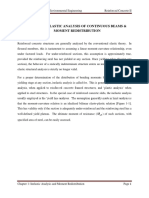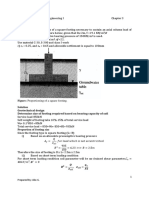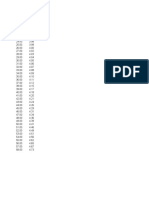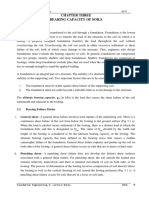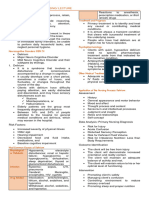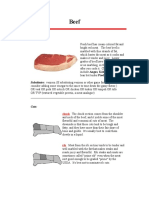Recitation 5A
Recitation 5A
Uploaded by
Shaminda AmbaheraCopyright:
Available Formats
Recitation 5A
Recitation 5A
Uploaded by
Shaminda AmbaheraCopyright
Available Formats
Share this document
Did you find this document useful?
Is this content inappropriate?
Copyright:
Available Formats
Recitation 5A
Recitation 5A
Uploaded by
Shaminda AmbaheraCopyright:
Available Formats
1
RETAINING WALL PROBLEMS
P1. CANTILEVER RETAINING WALL
Ouestion
For the retaining wall and the profile shown below, calculate:
a. The safety factor against overturning,
b. The safety factor against sliding (minimum required F.S. =1.5),
Do not consider the passive resistance of the fill in front of the wall.
c. If the overturning safety is not satisfactory, extend the base to the right and satisfy the
overturning stability requirement.
If the sliding is not satisfactory, design a shear key (location, thickness, depth) under the
base slab to satisfy the sliding stability. Take advantage of passive resistance of the
foundation soil. Calculate the vertical stress starting from the top level of the base but
consider the passive resistance starting from the bottom level of the base slab (i.e. in the
sand). Use a factor of safety of 2.0 with respect to passive resistance.
0.5m
q=30kPa
SURCHARGE
GRANULAR
7m
BACKFILL
1m
1m
c=0 |=30
0
=18kN/m
3
=20 kN/m
3
FILL
1m
BASE SLAB
5m
MEDIUM DENSE SILTY SAND
c=0, |=32
0
, =20kN/m
3
, tano=0.5(base friction) ,
conc
=24kN/m
3
2
Solution:
0.5m q=30kPa
GRANULAR
V
4
BACKFILL
c=0
7m
|=30
0
=18kN/m
3
H1
=20 kN/m
3
FILL 1m
1m
V1
V5
H2
V2
1m
V
3
5.0m
K
a
=tan
2
(45-|/2)
For granular backfill K
a
=tan
2
(45-30/2)=0.333
Active pressure, p
a
=(q+z)K
a
-2c\Ka
z=0 p
a
=30x0.333=10 kN/m
2
z=8 o
a
=(30+18x8)0.333=58 kN/m
2
Force(kN/m)
V
1
=0.5x7x24=84
Arm,about toe(m)
1.25
Moment(kN.m/m)
105
V
2
=0.5x7x1/2x24=42 1.67 70
V
3
=1x5x24=120 2.5 300
V
4
=0.5x7x1/2x18=31.5 1.83 57.75
V
5
=3x7x18=378 3.5 1323
EV=655.5 EM
r
=1855.75
H
1
=10x8=80 4 320
H
2
=(58-10)x8x1/2=192
EH=272.0
8/3 512
EM
ov
=832
10kPa 48kPa
3
2
a)
(F.S.)
ov
=
M
r
M
ov
=
1855.75
= 2.23
832
(F.S.)
ov
=2.23>2.0 O.K.
c=0(at the base) do not consider
b)
(F.S.)
sliding
=
V. tan o + (2 / 3cB) + P
p
H
(F.S.)
sliding
= V. tan o = 655.5x0.5 = 1.20
H 272
(F.S.)
sliding
=1.20<1.5 NOT O.K. DESIGN BASE KEY
c)
Base key design:
Passive resistance at the base key;
FILL, =20kN/m
3
1m
P
1 D
P
2
65D 65
K
p
=tan
2
(45+32/2)=3.25
z=0 p
p
=1x20x3.25=65 kPa
z=D p
p
=(1x20+20xD)x3.25=65+65D kPa
P
p
=P
1
+P
2
=65D+1/2x65D
2
Use F.S.=2.0 w.r.t. passive resistance P
p
=1/2(65D+1/2x65D
2
)
(F.S.)
sliding
V. tan o + P
p
=
H
=
655.55x0.5 + 1/ 2(65D + 1/ 2x65D )
272
= 1.5
4
Then, 65D+32.5D
2
=160.5 D=1.43m
If passive resistance (with a F.S. of 2.0) is subtracted from the driving horizontal
forces, (i.e. used in the denominator)
Use F.S.=2.0 w.r.t. passive resistance P
p
=1/2(65D+1/2x65D
2
)
(F.S.)
sliding
= V. tan o = 1.50
H-Pp
Then, D=1.07m
Take D=1.43m as it is on safe side.
5
Soil properties: I)
1
=18.5 kN/m
3
, |
1
=32
0
, c
1
= 0
II)
2
=18.0 kN/m
3
, |
2
=24
0
, c
2
= 30 kN/m
2
P2. GRAVITY RETAINING WALL
Ouestion
A gravity retaining wall is shown below. Use o=2/3 | and Coulomb active earth pressure
theory. Determine
a. The factor of safety against overturning
b. The factor of safety against sliding
c. Calculate base pressures for both cases;
- considering the passive pressure, and
- neglecting it.
concrete
=24 kN/m
3
5m
0.77m
1.53m
1
=18.5kN/m
3
|
1
=32
c
1
=0
2
=18.5kN/m
3
|
2
=24
C
2
=30kN/m
3
0.8m
I
II
3.5m
1.5m
0.3m
0.3m
0.60m
5.7m
II
75
6
a
Note: In Coulombs active earth pressure theory, the forces to be considered are only
P
a
(Coulomb) and weight of the wall i.e. the weight of the soil above the back face of the
wall is not taken into account.
Coulomb active forces;
P
a
=
1
H
2
K
2
where
H =Height of the wall
K
a
= Coulombs active earth pressure coefficient
2 2
2
)
) sin( ). sin(
) sin( ). sin(
1 ).( sin( . sin
) ( sin
| o o |
o | o |
o | |
| |
+
+
+
+
=
a
K
With horizontal backfill; o=0
With vertical retaining wall; |=90
o: friction between the wall and adjacent soil
o
o
|
H
7
a
Solution:
For o=0
0
|=75
0
|=32
0
K
a
=0.4023 (use eqn. 1)
o=(2/3)x32=21.3
0
P
a
=
1
..H
2
.K =
2
1
x18.5x6.5
2
2
x0.4023 = 157.22 kN / m
P
h
= P
a
.cos(15 + o) =157.22 x cos 36.3 =126.65 kN / m
P
v
= P
a
.sin(15 + o) =157.22 x sin 36.3 = 93.15 kN / m
5m
0.77m 1.53m
1
=18.5kN/m
3
|
1
=32
c
1
=0
o=2/3|=21.3
2
=18.5kN/m
3
|
2
=24
c
2
=30kN/m
3
0.8m
I
II
3.5m
1.5m
0.3m
0.3m
0.60m
5.7m
II
3
2
1
4
H/3=2.17m
15
75
o=21.3
P
AV
P
AH
P
A
c
=24kN/m
3
8
Force Moment arm about pt. A Moment
(kN/m) (m) (kN.m/m)
1) (
1
x1.53x5.7)x24 = 104.65
2
2) (0.6x5.7)x24 = 82.08
3) (
1
x0.77x5.7)x24 = 52.67
2
4) (3.5x0.8)x 23.58 = 67.20
2.18 228.14
1.37 112.45
0.81 42.66
1.75 117.60
P
v
= 93.15 2.83 263.61
EV=399.75 EM
resisting
=764.46
EM
overturning
= P
h
x H/3 = 126.65x 2.17 = 274.83 kN.m/m
a) (F.S.)
overt.
=
M
r
=
M
o
764.46
=
274.83
2.78
> 2.0 O.K.
Note: if there is cohesionless soil at the base (c=0)
ignore this term
V. tan o + (
2
.c
2
.B) + P
p
3
if passive pressure is considered
b) (F.S.)
sliding
=
H
o=(2/3)x|
2
(F.S)
- P
p
is ignored
399.75x tan(
2
x24) + (
2
x30x3.5)
=
3 3
= 1.46
sliding
126.65
9
c. Pressure on soil at toe and heel
-If P
p
is ignored
EM
net
=764.46-274.83=489.63 kN.m/m
m
V
M
x
net
22 . 1
75 . 399
63 . 489
= = =
m x
B
e 53 . 0 22 . 1
2
5 . 3
2
= = =
=
5 . 3
53 . 0 6
1
5 . 3
75 . 399
max
min
x
q
-If P
p
is considered
K
p
= (1+sin24)/(1-sin24)=2.37
p
p
@z=0 = K
p
(z)+ 2c(K
p
)
0.5
=2x30x2.37
0.5
=92.40 kPa
p
p
@z=1.5 = K
p
(z)+ 2c(K
p
)
0.5
=2.37x18.5x1.5+ 92.40=65.80+92.40=155.20 kPa
M
res
(due to P
p
)=92.4x1.5
2
x0.5+0.5x65.80x(1/3)x1.5
2
=128.63 kN.m/m
EM
res
=764.46+128.63 = 893.09 kN.m/m
EM
net
=893.09-274.83=618.26 kN.m/m
m
V
M
x
net
55 . 1
75 . 399
26 . 618
= = =
m e 20 . 0 55 . 1
2
5 . 3
= =
=
5 . 3
20 . 0 6
1
5 . 3
75 . 399
max
min
x
q
q
max
=217.99 kN/ m
2
/ m (toe)
q
min
=10.44 kN/ m
2
/ m (heel)
q
max
=153.37 kN/ m
2
/ m (toe)
q
min
=75.05 kN/ m
2
/ m (heel)
EV
x
EV
x
A
A
B/2 B/2
B/2 B/2
10
P3. REINFORCED EARTH WALL
Ouestion:
A reinforced earth wall is to be constructed as shown in the figure below. The material that
will be used as backfill shall have the following properties, =17 kN/m
3
, |=30
0
, c=0. The
strips will be galvanized steel and will have a width of 75mm. The yield stress for strip
material is f
y
=3x10
5
kN/m
2
.
a. Design the reinforcements (i.e. determine the length and thickness) by using a factor of
safety of 3.0 for both tie-breaking and pull-out.
b. Find the factor of safety al ong sliding on the base and calculate the base pressures for
the foundation soil.
- Design life for structure 50 yrs.
- Corrosion=0.025 mm/yr
- Use Rankine Earth Pressure Theory and take the friction angle between soil and
reinforcement as 20
0
2.0 m
q=20 kN/m
2
1
st
reinforcement
6.0 m
S
v
=0.75m
4
S
h
= 1.00m
8
6.0 m
6.4 m
12
16
11
Solution:
2.0 m
1
L
wedge
L
e
6.67 kPa
6.0 m
8
6.0 m
6.4 m
45+|/2=60
0
16
76.93 kPa
|=30
0
K
a
= 1/3
a) Design of reinforcement
As far as the tie breaking is concerned, bottom reinforcement (16) is the most critical one
since the lateral pressure is maximum at that level.
s
v p
a
=(z+q)K
a
-2c(K
a
)
0.5
t
w
(F.S.)
breaking
=
w.t.f
y
T
max
= 3.0
T = S
v
.S
h
.(z + q) K
a
T
max
= 0.75x1.0x (12x17 + 20)x
1
= 56 kN
3
12
5
(F.S.)
breaking
=
0.075 x t x3x10
56
= 3.0
t = 7.46 mm
Corrosion rate 0.025mm/yr. x 50 =1.25mm
t=7.46+1.25 = 8.71mm
USE t
design
=9mm
- As far as tie pull-out is concerned,
o
v
=(z+q)
o
v
tan|
t
w
Le
Frictional resistance is
available on both surface
(top and bottom)
Friction angle
between soil and
reinforcement
(F.S.)
pullout
=
2(z + q) tan |
L
e
w
(z + q)K
a
S
v
S
h
=
2 tan |
L
e
w
K
a
S
v
S
h
= 3.0
(F.S.)
pullout
=
2x0.075xL
e
x tan 20
1
x0.75x1.0
3
= 3.0 L
e
= 13.7m
Since first reinforcement (1) is the most critical one when the pull-out criterion is
concerned,
tan(45-|/2)=
L
wedge
+ 2
12.4 0.75
L
wedge
= 4.72m
- Total tie length L=L
wedge
+L
e
=13.7+4.72=18.42m for upper 6m of the wall
- For lower 6m of the wall , L=20.42m
13
b) (F.S.)
sliding
and Base Pressure
18.42m
q=20 kPa
6.67 kPa
6.0m
W
1
H
1
6.4m
H
2
W
2
A
20.42m
76.93 kPa
Forces (kN/m) Moment arm, about A (m) Moment (kN.m/m)
W
1
=18.42x6.0x17=1878.8 11.21 21061
W
2
= (18.42+2)x6.4x17 = 2221.7 10.21 22684
Load = 20x18.42 = 368.4 11.21 4130
EF
v
= 4469
H
1
= 6.67x12.4 = 82.7
12.4 /2
EM
r
= 47875
512.7
H
2
= (76.93-6.67)x12.4x(1/2) = 435.7 12.4 /3 1800
EF
h
= 518 EM
ov
= 2313
(FS)
sliding
= (EF
v
. tan o) / EF
h
In gravity or cantilever retaining walls, at the base of the wall, we would use tan o for soil-wall
friction. However in this problem, we see that, at the bottom of the wall, there is soil-soil
interface, therefore we should use the friction angle of the soil in the F.S. sliding equation. (If
two soils have different internal friction angles, the lower value should be used).
14
(FS)
sliding
= (4469 x tan30) / 518
= 4.98
X = EM
net
/ EF
v
= (47875 2313) / 4469 =10.2 m
e = B/2 X = (18.42 + 2)/2 10.2 = 0.01 ~ 0 no eccentricity
q
max
= EF
v
/ B = 4469 / 20.42
= 218.85 kN/m
2
/ m
You might also like
- 22 Non-Negotiable Laws of Wellness DiscussionDocument81 pages22 Non-Negotiable Laws of Wellness DiscussionMark Joel Ragndan DulayNo ratings yet
- Chapter 9. Design of ColumnDocument14 pagesChapter 9. Design of ColumnDelina TedrosNo ratings yet
- Lecture Notes Lectures 10 12 Stability of SlopesDocument89 pagesLecture Notes Lectures 10 12 Stability of SlopesPenelope MalilweNo ratings yet
- RC Retaining Wall NoteDocument17 pagesRC Retaining Wall NoteMat Zoul100% (2)
- Chapter 2 Earthquake LoadsDocument17 pagesChapter 2 Earthquake LoadsTESFAYE100% (3)
- Khosla DesignDocument37 pagesKhosla DesignArenPrajapatiNo ratings yet
- PART 5 WIND LOAD ExampleDocument20 pagesPART 5 WIND LOAD Exampledhammika dasanayakeNo ratings yet
- Chapter One: Reinforced Concrete Structures 2Document51 pagesChapter One: Reinforced Concrete Structures 2Olesea NesterencoNo ratings yet
- Design Aids-2015Document106 pagesDesign Aids-2015weynNo ratings yet
- Assignment IDocument4 pagesAssignment IPoly Zan100% (1)
- Chapter 10 - Example Problems Related To Shear Strength of - 2017 - Soil MechaniDocument21 pagesChapter 10 - Example Problems Related To Shear Strength of - 2017 - Soil MechaniTom CaineNo ratings yet
- 6 Column DesignDocument33 pages6 Column DesignEpoka's EngNo ratings yet
- Fem TetrahedronDocument23 pagesFem TetrahedronvijayaragavanNo ratings yet
- Chapter 3 Shear ExamplesDocument30 pagesChapter 3 Shear ExamplesRefisa JiruNo ratings yet
- Tutorial 5 - Flexural Members - Lateral Torsional BucklingDocument32 pagesTutorial 5 - Flexural Members - Lateral Torsional BucklingChan Keng ChunNo ratings yet
- Assignment Highway Engg For 2013Document5 pagesAssignment Highway Engg For 2013amareNo ratings yet
- Chapter 1. Inelastic Analysis of Continuous Beams & Moment RedistributionDocument19 pagesChapter 1. Inelastic Analysis of Continuous Beams & Moment RedistributionNatty TesfayeNo ratings yet
- STB 2006Document10 pagesSTB 2006nuwan01100% (1)
- Design of Beam Sections For ShearDocument5 pagesDesign of Beam Sections For ShearAmanuel Ashenafi100% (1)
- Numerical ProblemsDocument20 pagesNumerical ProblemsMass RajNo ratings yet
- Example 4.1:: Figure: Proportioning of A Square Footing. SolutionDocument51 pagesExample 4.1:: Figure: Proportioning of A Square Footing. SolutionJedidiah MelakuNo ratings yet
- Stair Case DesignDocument4 pagesStair Case DesignTefera TemesgenNo ratings yet
- RC I Questions For TutoarialDocument15 pagesRC I Questions For Tutoarialletaabera2016No ratings yet
- Column ExampleDocument38 pagesColumn ExampleHelen NegashNo ratings yet
- Designof Retaining WallDocument7 pagesDesignof Retaining WallPrabhu Nath SinghNo ratings yet
- Isolated - Foundation Design ES en 2015Document10 pagesIsolated - Foundation Design ES en 2015Dino AbdelaNo ratings yet
- GROUP6 - GC42 - Design of Column Beam and SlabDocument8 pagesGROUP6 - GC42 - Design of Column Beam and SlabAlexander P. BelkaNo ratings yet
- Consistent Deformation MethodDocument14 pagesConsistent Deformation MethodParth AnajwalaNo ratings yet
- Project On GED IIDocument4 pagesProject On GED IIakhjazrNo ratings yet
- Multiple-Choice Test Runge-Kutta 4th Order Method: y X Xy DX DyDocument3 pagesMultiple-Choice Test Runge-Kutta 4th Order Method: y X Xy DX DyDr Razak Olusegun Alli-Oke100% (1)
- Chapter - 4 - Design of Footings-4-Strap FootingDocument11 pagesChapter - 4 - Design of Footings-4-Strap FootingAdisalem Belay100% (1)
- One Way Slab ExampleDocument18 pagesOne Way Slab Examplegizachewgirma551No ratings yet
- Worked Example Performance Check Capacity of A Nailed ConnectionDocument4 pagesWorked Example Performance Check Capacity of A Nailed ConnectionnjornorNo ratings yet
- Example and ExerciseDocument7 pagesExample and ExercisesamiNo ratings yet
- Distributing The Load of Bridges Over The GirdersDocument28 pagesDistributing The Load of Bridges Over The GirdersovikbasuNo ratings yet
- Design of Tension MembersDocument11 pagesDesign of Tension MembersWilfharry billyNo ratings yet
- Cantilever Retaining WallDocument4 pagesCantilever Retaining WallVasu BhaskarNo ratings yet
- 3.2-Bearing Capacity of SoilsDocument23 pages3.2-Bearing Capacity of SoilsSamson Yonas100% (1)
- Foundation Engineering Ii - Ceng 4142 Assignment On Pile FoundationDocument1 pageFoundation Engineering Ii - Ceng 4142 Assignment On Pile Foundationabdu yimer100% (1)
- Prob 09Document5 pagesProb 09NAVIN SHAHNo ratings yet
- EjerciciosDocument14 pagesEjerciciosmmontesmNo ratings yet
- Chapter Iii. Limit State DesignDocument19 pagesChapter Iii. Limit State DesignisaacssebulibaNo ratings yet
- 4-Flexural Members or Beams PDFDocument39 pages4-Flexural Members or Beams PDFKellen Brumbaugh100% (1)
- Strip Method Best WordDocument28 pagesStrip Method Best WordLeomark RespondeNo ratings yet
- Important Point To Consider From ES EN 1992-1-1:2015: Shear Design TheoryDocument4 pagesImportant Point To Consider From ES EN 1992-1-1:2015: Shear Design TheorySEMAHEGNNo ratings yet
- Chapter Two: Limit State DesignDocument12 pagesChapter Two: Limit State Designdilnessa azanawNo ratings yet
- Analisis Struktur C6Document47 pagesAnalisis Struktur C6Hazyema HarunNo ratings yet
- CE 441 - Lec03 - BC of Shallow FDN in Clay V1Document38 pagesCE 441 - Lec03 - BC of Shallow FDN in Clay V1Md. Nahin Al ZakiNo ratings yet
- Problems - Module 5Document7 pagesProblems - Module 5Tanvir Rajib 191-47-234No ratings yet
- Temam Mohammed HS 2Document16 pagesTemam Mohammed HS 2Temam MohammedNo ratings yet
- Chapter 2Document15 pagesChapter 2Refisa JiruNo ratings yet
- Chapter 2 STR 4 Torsion in BeamsDocument17 pagesChapter 2 STR 4 Torsion in BeamsAbera MamoNo ratings yet
- CES521 - 7 - Flexibility MethodDocument101 pagesCES521 - 7 - Flexibility MethodImran37Afiq100% (1)
- 5.3 Slab 5.3.1 Slab: Office Area: Ref. Calculation OutputDocument27 pages5.3 Slab 5.3.1 Slab: Office Area: Ref. Calculation OutputNH SyzlnNo ratings yet
- Numerical Methods and Implementation in Geotechnical Engineering – Part 1From EverandNumerical Methods and Implementation in Geotechnical Engineering – Part 1No ratings yet
- Retaining Wall Problems: Surcharge Q 30kpaDocument15 pagesRetaining Wall Problems: Surcharge Q 30kpaZayyan RomjonNo ratings yet
- P1. Anchored Sheet Pile Wall OuestionDocument10 pagesP1. Anchored Sheet Pile Wall OuestionShaminda AmbaheraNo ratings yet
- Wing Wall DesignDocument19 pagesWing Wall DesignMAGED MOHMMED AHMED QASEMNo ratings yet
- Anchored Sheet Pile WallDocument10 pagesAnchored Sheet Pile Wall12151973No ratings yet
- Assignment 3 Solution A3 Bearing Capacity Rev 1Document8 pagesAssignment 3 Solution A3 Bearing Capacity Rev 1Cho Wing SoNo ratings yet
- Pile Foundation Concrete Column DesignDocument34 pagesPile Foundation Concrete Column DesignAlfredo A LopezNo ratings yet
- NAVY T-44 Training WorkbookDocument168 pagesNAVY T-44 Training WorkbookjjfugedyNo ratings yet
- Azam M. Mind Maps For Medicine 2021Document160 pagesAzam M. Mind Maps For Medicine 2021provis10No ratings yet
- Edgar Allan Poe Exam 1Document5 pagesEdgar Allan Poe Exam 1cynthiaaa sNo ratings yet
- In-Situ Insulation Test of 400 KV GIS: H. Mohseni, J. Jadidian, A. A. Shayegani-Akmal, E. Hashemi, A. Naieny E. AghebDocument7 pagesIn-Situ Insulation Test of 400 KV GIS: H. Mohseni, J. Jadidian, A. A. Shayegani-Akmal, E. Hashemi, A. Naieny E. Aghebnamsaigon316No ratings yet
- Poseidon-1: Trusted Offshore Geotechnical SolutionsDocument4 pagesPoseidon-1: Trusted Offshore Geotechnical Solutionskyle krugerNo ratings yet
- Easy Fry & Grill Digital: EN FR ESDocument20 pagesEasy Fry & Grill Digital: EN FR ESEvan López IslasNo ratings yet
- TRF2122 Jun0321 TTIDocument310 pagesTRF2122 Jun0321 TTIkafi1234No ratings yet
- Session 3-1: Financial Literacy and Household Behavior Implications For Asia by Joanne YoongDocument20 pagesSession 3-1: Financial Literacy and Household Behavior Implications For Asia by Joanne YoongADBI Events100% (2)
- 0460 Example Candidate Responses Paper 1 (For Examination From 2020)Document45 pages0460 Example Candidate Responses Paper 1 (For Examination From 2020)Iulian MitranNo ratings yet
- Olga Ramirez: 1331 John Wayne RD Kaufman, TX 75142 (214) 723-8583Document2 pagesOlga Ramirez: 1331 John Wayne RD Kaufman, TX 75142 (214) 723-8583api-272659451No ratings yet
- Lab ReportDocument17 pagesLab ReportYan ZongNo ratings yet
- HRI 2011 Complete Report PDFDocument340 pagesHRI 2011 Complete Report PDFJojo75000No ratings yet
- Week 12 Underground Excavations & TunnelsDocument28 pagesWeek 12 Underground Excavations & TunnelsRashid AhmedovNo ratings yet
- Image Based Plant Disease Detection by Using Deep LearningDocument15 pagesImage Based Plant Disease Detection by Using Deep LearningIJRASETPublicationsNo ratings yet
- Radcal 9015Document111 pagesRadcal 9015samuel mNo ratings yet
- Topic: - ACI Nutrilife Low GI Rice Marketing Plan: Group ProjectDocument14 pagesTopic: - ACI Nutrilife Low GI Rice Marketing Plan: Group ProjectMukut zubaer KhandkerNo ratings yet
- Structure of Atom: Sub-Atomic Particles: Name Symbol Charge/C Relative Charge Mass/kgDocument8 pagesStructure of Atom: Sub-Atomic Particles: Name Symbol Charge/C Relative Charge Mass/kgSparsh MehtaNo ratings yet
- Dear Parent or GuardianDocument2 pagesDear Parent or Guardianapi-321186495No ratings yet
- Cognitive DisordersDocument4 pagesCognitive DisordersJustine BayabosNo ratings yet
- F 311 - 08 (2013)Document3 pagesF 311 - 08 (2013)juan fNo ratings yet
- Qatar Petroleum - A Closer LookDocument37 pagesQatar Petroleum - A Closer Lookselvajee2000100% (1)
- Unit 2 - Lesson 1 - Activity 1 & 2 - SLP 1Document7 pagesUnit 2 - Lesson 1 - Activity 1 & 2 - SLP 1Guia Marie BobaresNo ratings yet
- Foundation of Physical Education UNIT 2Document6 pagesFoundation of Physical Education UNIT 2Sreelakshmi MuttomNo ratings yet
- Pe 8 - q4 - Week 5 - Mae C. MillaDocument13 pagesPe 8 - q4 - Week 5 - Mae C. MillaAllenmay LagorasNo ratings yet
- Stuttering and Its Treatment - Eleven Lectures February 2019 - 1 PDFDocument311 pagesStuttering and Its Treatment - Eleven Lectures February 2019 - 1 PDFNermin TelovskaNo ratings yet
- BeefDocument2 pagesBeefBonophool BanerjeeNo ratings yet
- Maternity Benefit Act 1961Document13 pagesMaternity Benefit Act 1961Rohit MandyalNo ratings yet
- What Is OsmosisDocument4 pagesWhat Is OsmosisMBOTAKE LawsonNo ratings yet
- QCS-2010 Section 21 Part 31 Power Distribution Transformers PDFDocument3 pagesQCS-2010 Section 21 Part 31 Power Distribution Transformers PDFbryanpastor106No ratings yet
















